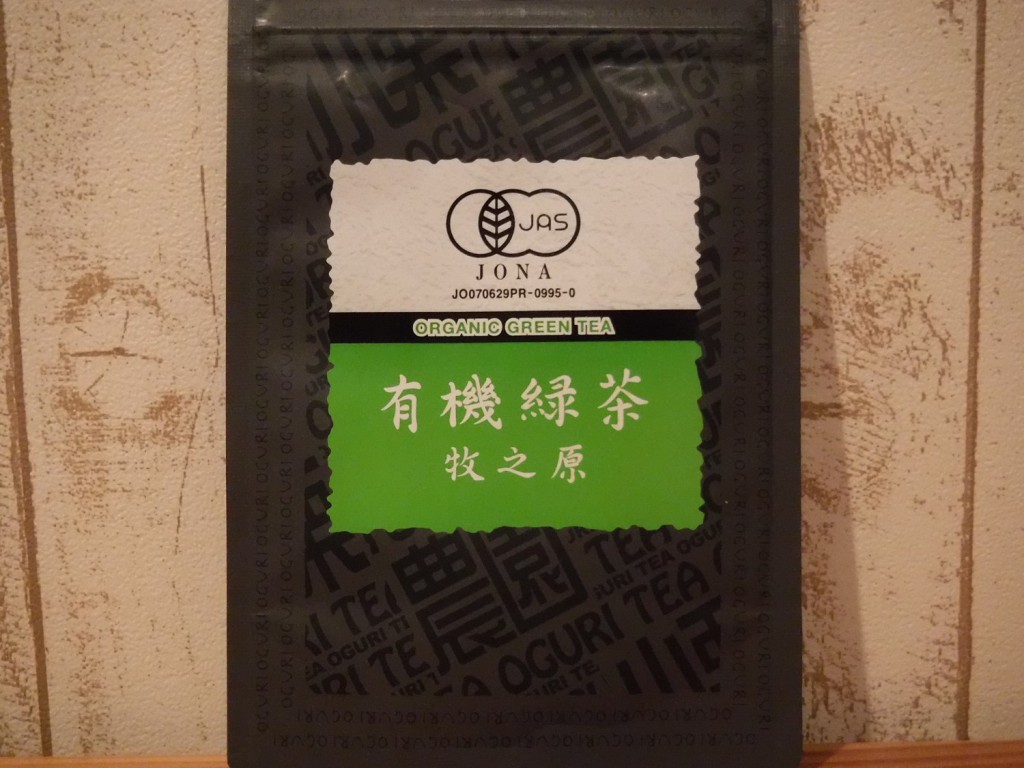
My favorite organic tea produced by Oguri Farm in Makinohara.
The demand for organic tea seems to have been gaining year by year. On the other hand, organic tea is not enough to be supplied to markets in many countries, I feel. Based on the increasing demand worldwide for organic tea, FAO has organized a working group on organic tea. As the working group in FAO reported, there are some issues in the production of organic tea such as yield reduction, higher cost of cultivation owing to increase man days requirement [394]. Besides, I think technical limitation in cultivation is also one of the issues.
In my opinion, there are little investigations for organic tea production. On the other hand, there are some studies of particular technique which could contribute to organic cultivation of tea. For example, Koga et al. (1992) reported that longterm successive input of organic matters (e.g. manure, rice straw, silver glass etc.) could improve soil properties such as CEC, total nitrogen content etc. and result in better yield and higher sensory quality [14]. Longterm successive application of manure can increase diversity of microorganisms (Fig.1) and turnover rate of biomass nitrogen under acidic soil in tea plantation (Fig.2) [3].
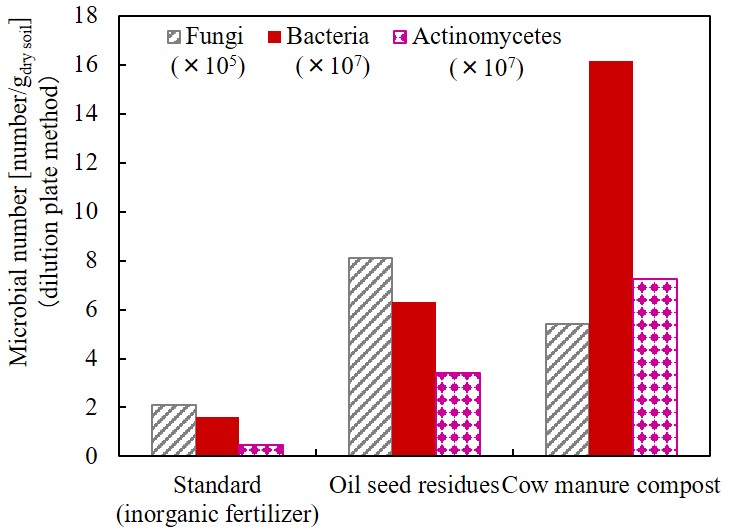
Fig.1 Effect of successive application of organic matter on the diversity of microorganisms.
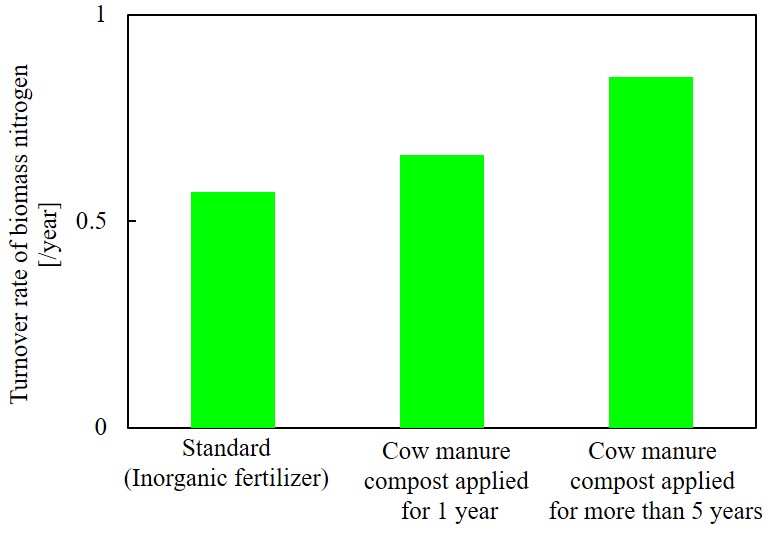
Fig.2 Effect of successive manure application on the turnover rate of biomass nitrogen.
The effect of organic fertilizer on tea flavor has been also investigated. Saigo et al. reported higher sensory quality of the tea cultivated using organic fertilizer than the tea cultivated by standard method using chemical fertilizer, even though there are little difference in chemical compositions between organically produced one and the standard [13]. The tendency is recognized among some tea farmers and tea traders. In the study meeting of young tea farmers in Makinohara, some tea farmers say their client tea traders recognize teas cultivated using organic fertilizer has more excellent flavor and ask them to manage tea plantation using organic matter.
In spite of the attractive aspects of organic cultivation, there are big two issues inhibiting the shift to organic cultivation. The first is pest management, the second is minimizing labor cost for weed management. I’d like to share the present and future technologies to facilitate research activities for organic tea farming.
(1) Pest Management
As for the management of pests, integrated pest management so-called IPM is widely studied and practiced for greener and more environmental-friendly cultivation [472, 476]. It is heard from some tea farmers who practice organic tea farming that a gradual shift from conservative management to organic manner is recommended because immediately stopping pesticides often results in sudden increase of pests and consequential yield decrease. Based on the report of the working group on organic tea in FAO [394], the gradual shift to organic management could be adequate. Conservation biological control has also been studied and practiced.
Based on the reports for IPM and conservation biological controls, countermeasures for pests actually studied and practiced are as follows, as well as I know.
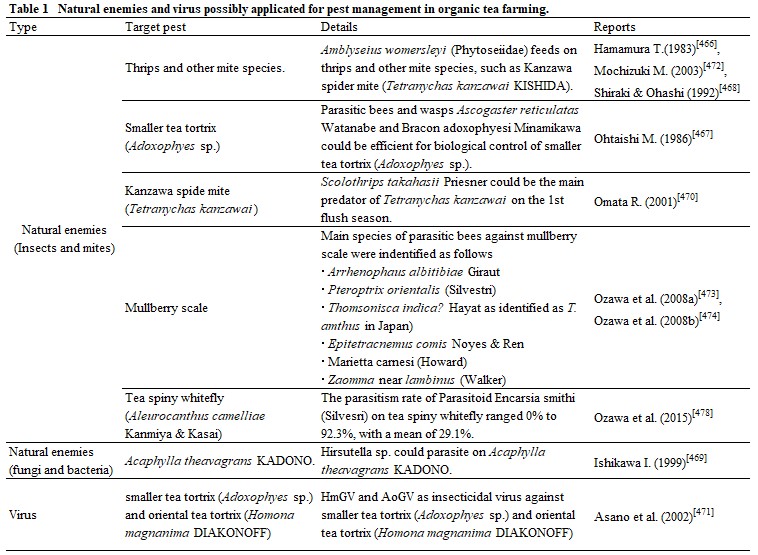
In addition, a working group on robotics for tea farming has been organized in Shizuoka prefecture. Now the working group is investigating the application method of drone for the purpose of early detection of symptom or signs of pests.
I hope new technologies for efficient pest management without agrichemicals. For example, application of laser light has been studied and lately developed as a concrete technique [PA006]. Such research seems to have been started since the end of 20th century [PA005]. For the purpose of applying the technology, the effect of laser on crops has been studied in Japan too [461]. The technology to protect farmland from some insect species has been established as “Photonic Fence” [PA005].
Although I have no ideas the possibility to apply the laser apparatus for pest management in tea plantation, I really hope the technology would improve the organic management of tea plantation. Hopefully the application of newer technologies for tea cultivation would be accelerated by cooperation among technology companies, manufacturers of machineries for tea plantation management, research institutes etc.
(2) Weed Management
In organic tea farming, weed removal requires the longest labor work [59]. Of course, there are some countermeasures such as mulching by bio-materials [481], usage of covering plants [479, 480] and grazing livestock in tea plantation.
For example, silver grass mulching has been widely practiced since long ago. Especially Kakegawa tea estate is famous for the practice known as “Traditional Tea-Grass Integrated System”, which is certified as GIAHS by FAO.
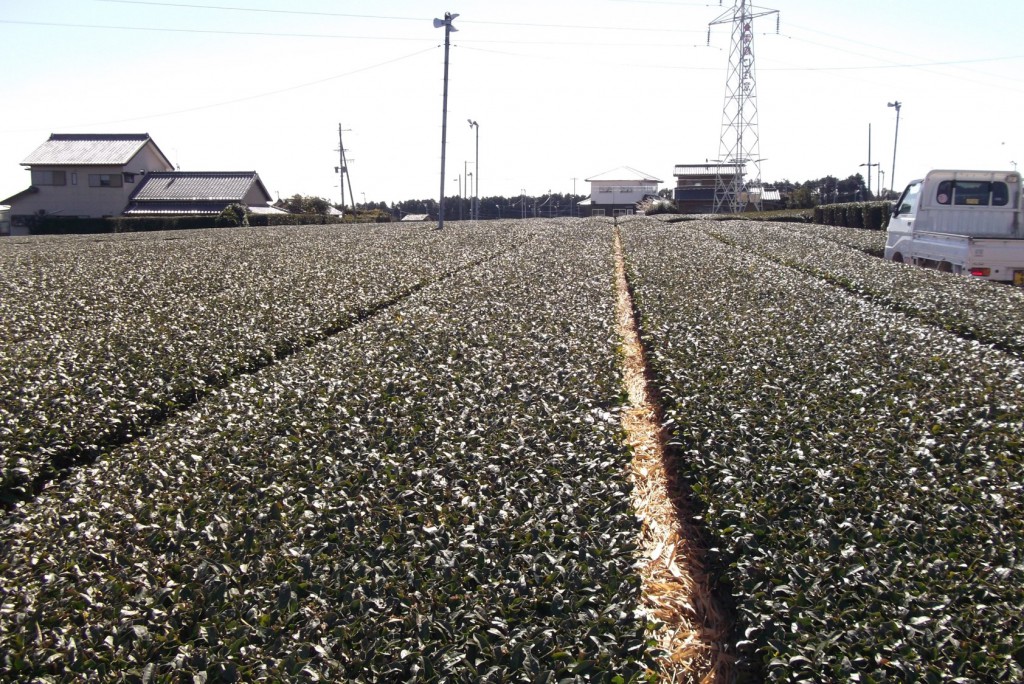
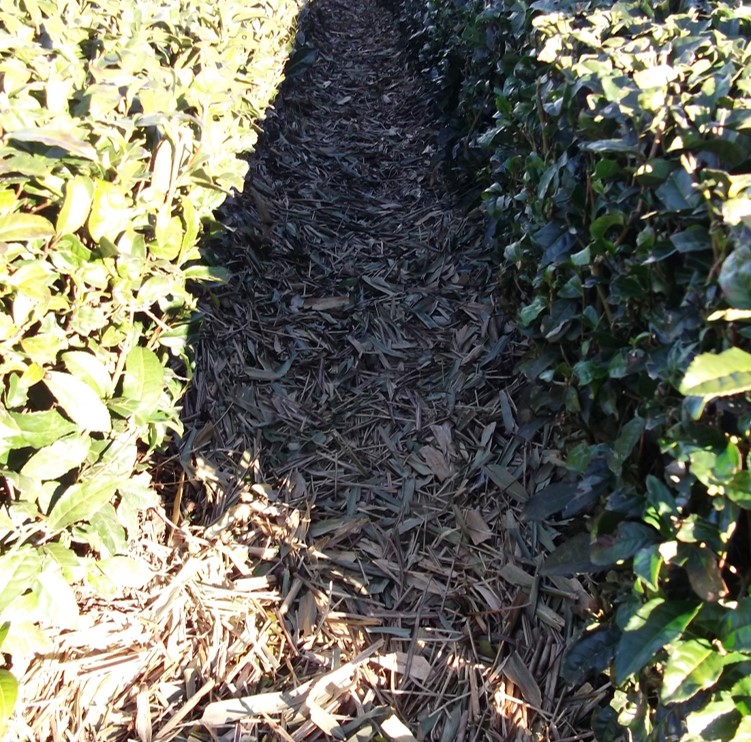
In addition, other organic matters are applied such as rice bran and livestock manure.
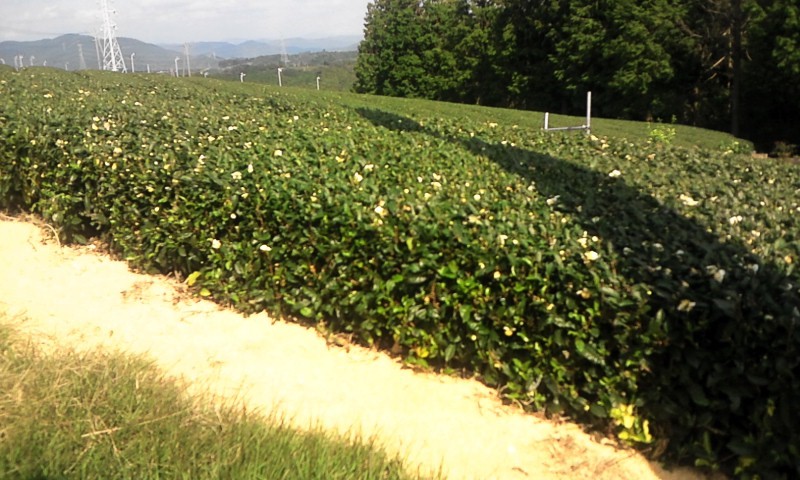
An example of rice bran mulching.
As for the livestock grazing, Mr. Shibamoto practices goats grazing.
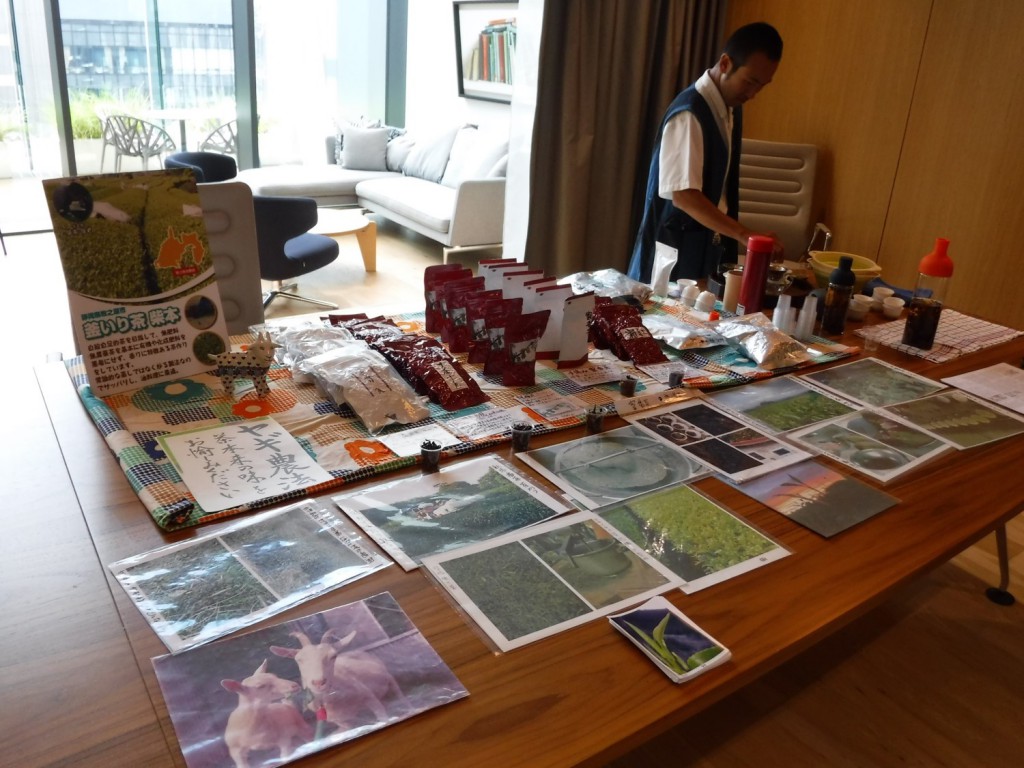
Mr. Shibamoto exhibits various photo on his tea farm. The photo on this side shows two cute goats. They are grazed on his tea farm and eat weeds.
As future issues, laser application is also expected for weed control [461].
Surprisingly, an automatic weeding machine “Tertill” has been launched by Franklin Robotics!! It’s like a Roomba! Yes, the developer is co-creator of Roomba, Joe Jones, CTO Franklin Robotics. He explains the Roomba in garden “Tertill” in a youtube movie.
Although it might be difficult to use the Tertill itself in tea plantations because of higher soil roughness, customizing could develop a new efficient robot.
I hope cooperation between robotics companies like Franklin Robotics and manufacture companies of tea industry like Ochiai Cutlery Manufacturing co., ltd., Kawasaki Kiko co., ltd., Terada Seisakusho co., ltd., and Matsumotokiko co., ltd. The cooperation work could accelerate the improvement of tea industry more rapidly and efficiently!
I hope open innovations and collaborations enhance the evolution in tea industry!!
< References >
[3] Shiwa M. and Yoshizawa K. (2002) : Soil Biomass and Turnover Rate of Its Nitrogen in Tea Field, Chagyo Kenkyu Hokoku (Tea Research Reports in Japan), 94:29-36.
[13] Saigo T., Watanabe K., Morita M. and Nakano T. (1979) : Effect of Organic Fertilizer Application on the Growth of Tea Plant, Quality of Green Tea and Chemical Properties of Soils, Chagyo Kenkyu Hokoku (Tea Research Reports in Japan), 50:31-41.
[14] Koga R., Ide T., Nakashima S., Nagano Y. and Ishii K. (1992) : Chagyo Kenkyu Hokoku (Tea Research Reports in Japan), 75:1-11.
[59] Japan Soil Association (2013) : Technologies for organic tea farming, in Japan Soil Association (Eds.) Guidance for technologies in organic cultivation pp. 320-412.
[394] The Working Group on Organic Tea (2016) : Report of the working group on organic tea (Resolution in FAO-IGG conference in Naivasha, Kenya, 25-27 May 2016.
[461] Sato K., Umezaki T., Hoki M. and Takaki S. (2000) : Fundamental Study of Laser Application for Weed and Pest Control. Effect of Laser Emissions on Rice Plant Leaves, Journal of Japan Society of Agricultural Machinery, 62:98-103.
[466] Hamamura T. (1983) : Relationship between Kanzawa spider mite and predatory mite in tea plantation on June, Proceedings of Japanese Society of Applied Entomology and Zoology, 134:D-63.
[467] Oyasuji M. (1986) : Parasitic bees and wisp against smaller tea tortrix (Adoxophyes sp.) in the tea plantations, Proceedings of Japanese Society of Applied Entomology and Zoology, 157:Q12.
[468] Shiraki Y. and Ohashi T. (1992) : Seasonal changes of tea plant and their natural predators in pesticide-free and pesticide treated tea fields, Bulletin of Kanagawa Horticultural Experiment Station, 42:33-39.
[469] Ishikawa I. (1999) : Natural enemies against mites in tea plantation, Proceeding of the Japanese Society of Applied Entomology and Zoology, 31:B120.
[470] Omata R. (2001) : The influences of the omission agrochemicals application before the first and second green tea harvest on the occurrences of Kanzawa spider mite, Tetranychus kanzawai Kishida, and other tea pest insects, Bulletin of the Saitama Prefectural Agriculture and Forestry Research Center, 1:91-99.
[471] Asano S., Fukunaga K. and Takai A. (2002) : Effects of Climate Conditions on the Residual Activity of an Insecticidal Granulosis Virus Formulation, BCGV-01, Report of
[472] Mochizuki M. (2003) : Studies on use of the pesticide resistant predatory mite Amblyseius womersleyi Schicha (Acari: Phytoseiidae) for integrated pest management on tea plants, Bulleti of , 2:93-138.
[473] Ozawa A., Kubota S., Kaneko S. and Ishiguro S. (2008) : Research on the Natural Enemies of the Mulberry Scale, Pseudaulacaspis pentagona (Targioni), in Tea Fields in Shizuoka Prefecture, Japan. I. Species of Natural Enemies and Species Composition of the Parasitoids, Chagyo Kenkyu Hokoku (Tea Research Reports in Japan), 105:13-25.
[474] Ozawa A., Kubota S., Kaneko S. and Ishiguro S. (2008) : Research on the Natural Enemies of the Mulberry Scale, Pseudaulacaspis pentagona (Targioni), in Tea Fields in Shizuoka Prefecture, Japan. II. Seasonal Prevalence of Occurrences of Natural Enemies and the Relationship between the Host and the Parasitoids, Chagyo Kenkyu Hokoku (Tea Research Reports in Japan), 106:39-52.
[476] Hamada R. (2012) : Integrated Pest Management in Tea Cultivation, Bulletin of the Kochi Agricultural Research Center, 21:69-78.
[478] Ozawa A., Uchiyama T., Kosugi Y. and Haga H. (2015) : Distribution of the Parasitoid Encarsia smithi (Silvestri) on the Tea Spiny Whitefly Aleurocanthus camelliae Kanmiya & Kasai in Tea Fields in Shizuoka Prefecture Japan, Chagyo Kenkyu Hokoku (Tea Research Reports in Japan), 119:1-6.
[479] Watanabe H. and Saito K. (1964) : Studies on Sod Mulching and Straw Mulching in Tea Garden Part 1 – Influences of Sod Mulching and Straw Mulching on the Physical Properties of Soil in Young Tea Garden, Chagyo Kenkyu Hokoku (Tea Research Reports in Japan), 22:9-16.
[480] Watanabe H. and Saito K. (1972) : Studies on Sod Mulching and Straw Mulching in Tea Garden Part 2 – Influences of Sod and Straw Mulching on the Growth of Tea Plants and the Physical and Chemical Properties of Soil in Matured Tea Field, Chagyo Kenkyu Hokoku (Tea Research Reports in Japan), 37:24-31.
[481] Goto S. (2002) : Utilization of Felled Weed-Tree Branches after Chipping as Organic Materials at Newly Developed Tea Field, Chagyo Kenkyu Hokoku (Tea Research Reports in Japan), 94:15-28.
[PA005] W. Dudley Johnson (1994) : Method and apparatus for laser pest control, US5343652 A.
[PA006] Roderick A. Hyde et al. (2014) : Photonic fence, US8705017 B2.
